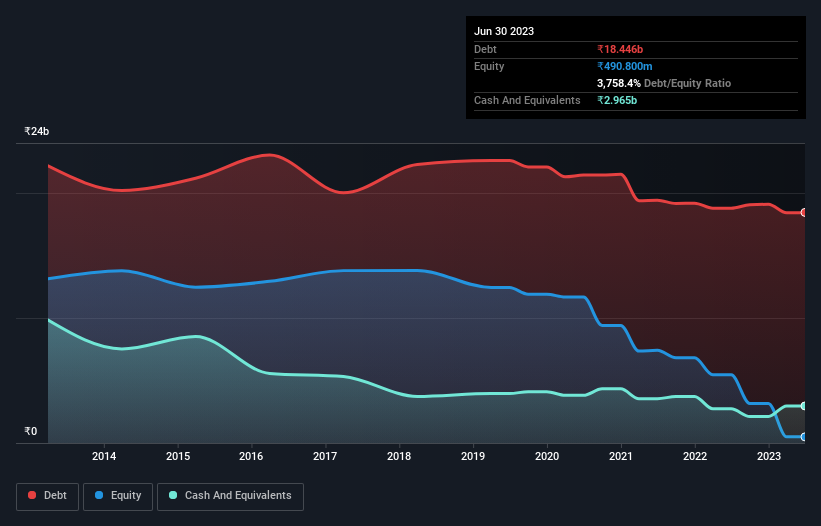- India
- /
- Electrical
- /
- NSEI:BGRENERGY
Does BGR Energy Systems (NSE:BGRENERGY) Have A Healthy Balance Sheet?

The external fund manager backed by Berkshire Hathaway's Charlie Munger, Li Lu, makes no bones about it when he says 'The biggest investment risk is not the volatility of prices, but whether you will suffer a permanent loss of capital.' So it might be obvious that you need to consider debt, when you think about how risky any given stock is, because too much debt can sink a company. As with many other companies BGR Energy Systems Limited (NSE:BGRENERGY) makes use of debt. But the real question is whether this debt is making the company risky.
What Risk Does Debt Bring?
Debt is a tool to help businesses grow, but if a business is incapable of paying off its lenders, then it exists at their mercy. If things get really bad, the lenders can take control of the business. However, a more usual (but still expensive) situation is where a company must dilute shareholders at a cheap share price simply to get debt under control. Of course, the upside of debt is that it often represents cheap capital, especially when it replaces dilution in a company with the ability to reinvest at high rates of return. The first step when considering a company's debt levels is to consider its cash and debt together.
See our latest analysis for BGR Energy Systems
What Is BGR Energy Systems's Net Debt?
The chart below, which you can click on for greater detail, shows that BGR Energy Systems had ₹18.4b in debt in March 2023; about the same as the year before. However, it also had ₹2.97b in cash, and so its net debt is ₹15.5b.

How Strong Is BGR Energy Systems' Balance Sheet?
Zooming in on the latest balance sheet data, we can see that BGR Energy Systems had liabilities of ₹44.3b due within 12 months and liabilities of ₹4.72b due beyond that. On the other hand, it had cash of ₹2.97b and ₹10.9b worth of receivables due within a year. So its liabilities total ₹35.2b more than the combination of its cash and short-term receivables.
This deficit casts a shadow over the ₹5.01b company, like a colossus towering over mere mortals. So we'd watch its balance sheet closely, without a doubt. At the end of the day, BGR Energy Systems would probably need a major re-capitalization if its creditors were to demand repayment. When analysing debt levels, the balance sheet is the obvious place to start. But it is BGR Energy Systems's earnings that will influence how the balance sheet holds up in the future. So if you're keen to discover more about its earnings, it might be worth checking out this graph of its long term earnings trend.
Over 12 months, BGR Energy Systems made a loss at the EBIT level, and saw its revenue drop to ₹6.8b, which is a fall of 45%. To be frank that doesn't bode well.
Caveat Emptor
While BGR Energy Systems's falling revenue is about as heartwarming as a wet blanket, arguably its earnings before interest and tax (EBIT) loss is even less appealing. Indeed, it lost a very considerable ₹3.0b at the EBIT level. Reflecting on this and the significant total liabilities, it's hard to know what to say about the stock because of our intense dis-affinity for it. Sure, the company might have a nice story about how they are going on to a brighter future. But the reality is that it is low on liquid assets relative to liabilities, and it lost ₹4.9b in the last year. So we think buying this stock is risky. There's no doubt that we learn most about debt from the balance sheet. However, not all investment risk resides within the balance sheet - far from it. For example BGR Energy Systems has 2 warning signs (and 1 which makes us a bit uncomfortable) we think you should know about.
If you're interested in investing in businesses that can grow profits without the burden of debt, then check out this free list of growing businesses that have net cash on the balance sheet.
Valuation is complex, but we're here to simplify it.
Discover if BGR Energy Systems might be undervalued or overvalued with our detailed analysis, featuring fair value estimates, potential risks, dividends, insider trades, and its financial condition.
Access Free AnalysisHave feedback on this article? Concerned about the content? Get in touch with us directly. Alternatively, email editorial-team (at) simplywallst.com.
This article by Simply Wall St is general in nature. We provide commentary based on historical data and analyst forecasts only using an unbiased methodology and our articles are not intended to be financial advice. It does not constitute a recommendation to buy or sell any stock, and does not take account of your objectives, or your financial situation. We aim to bring you long-term focused analysis driven by fundamental data. Note that our analysis may not factor in the latest price-sensitive company announcements or qualitative material. Simply Wall St has no position in any stocks mentioned.
About NSEI:BGRENERGY
BGR Energy Systems
Manufactures and sells capital equipment for power plants, petrochemical and process industries, and refineries in India and internationally.
Slight and slightly overvalued.
Market Insights
Community Narratives


